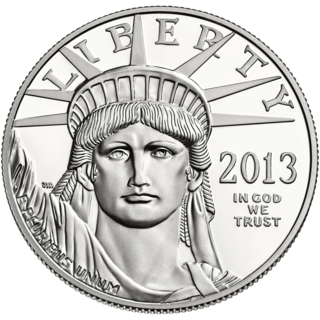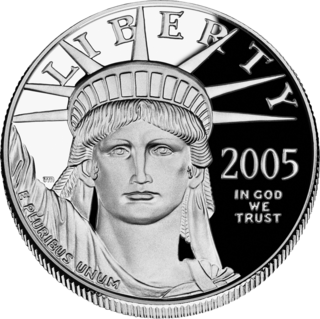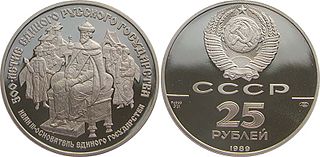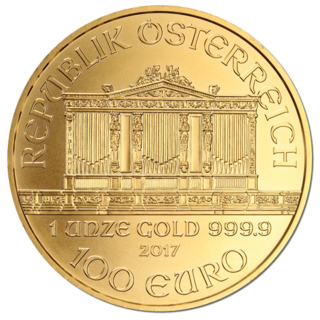Related Research Articles

Precious metals are rare, naturally occurring metallic chemical elements of high economic value. Chemically, the precious metals tend to be less reactive than most elements. They are usually ductile and have a high lustre. Historically, precious metals were important as currency but are now regarded mainly as investment and industrial raw materials. Gold, silver, platinum, and palladium each have an ISO 4217 currency code.

The maple leaf is the characteristic leaf of the maple tree. It is the most widely recognized national symbol of Canada.

The Royal Canadian Mint is the mint of Canada and a Crown corporation, operating under the Royal Canadian Mint Act. The shares of the Mint are held in trust for the Crown in right of Canada.
The fineness of a precious metal object represents the weight of fine metal therein, in proportion to the total weight which includes alloying base metals and any impurities. Alloy metals are added to increase hardness and durability of coins and jewelry, alter colors, decrease the cost per weight, or avoid the cost of high-purity refinement. For example, copper is added to the precious metal silver to make a more durable alloy for use in coins, housewares and jewelry. Coin silver, which was used for making silver coins in the past, contains 90% silver and 10% copper, by mass. Sterling silver contains 92.5% silver and 7.5% of other metals, usually copper, by mass.

The American Platinum Eagle is the official platinum bullion coin of the United States. In 1995, Director of the United States Mint Philip N. Diehl, American Numismatic Association President David L. Ganz, and Platinum Guild International Executive Director Jacques Luben began the legislative process of creating the Platinum Eagle. After over two years of work, the 99.95% fine platinum coins were released by the United States Mint in 1⁄10, 1⁄4, 1⁄2 and 1 troy oz denominations. In late 2008, the fractional denominations were discontinued, leaving only the one ounce denomination. The Platinum Eagle is authorized by the United States Congress, and is backed by the United States Mint for weight, content, and purity.

Britannia coins are British bullion coins issued by the Royal Mint in gold since 1987, in silver since 1997, and in platinum since 2018. The coin patterns feature various depictions of Britannia, a feminine personification of the United Kingdom.
The Canadian Gold Maple Leaf (GML) is a gold bullion coin that is issued annually by the Government of Canada. It is produced by the Royal Canadian Mint.

A bullion coin is a coin struck from refined precious metal (bullion) and kept as a store of value or an investment rather than used in day-to-day commerce. A bullion coin is distinguished by an explicit statement of weight and fineness on the coin; this is because the weight and composition of coins intended for legal tender is specified in the coinage laws of the issuing nation, and therefore there is no need for an explicit statement on the coins themselves.

Platinum coins are a form of currency. Platinum has an international currency symbol under ISO 4217 of XPT. The issues of legitimate platinum coins were initiated by Spain in Spanish-colonized America in the 18th century and continued by the Russian Empire in the 19th century. As a form of currency, these coins proved to be impractical: platinum resembles many less expensive metals, and, unlike the more malleable and ductile silver and gold, it is very difficult to work. Several commemorative coin sets have been issued starting from 1978 and became popular among coin collectors. The major platinum bullion coins include the American Platinum Eagle, the Canadian Platinum Maple Leaf, the Australian Platinum Koala, the Isle of Man Noble, the Chinese Platinum Panda, the Austrian Vienna Philharmonic and several series by the Soviet Union and later by the Russian Federation.

Palladium coins are a form of coinage made out of the rare silver-white transition metal palladium. Palladium is assigned the code XPD by ISO 4217. The first palladium coins were produced in 1966.
The Canadian Silver Maple Leaf is a silver bullion coin that is issued annually by the Government of Canada since 1988. It is produced by the Royal Canadian Mint.
One of the most profitable aspects of the Royal Canadian Mint (RCM) is its numismatic product line. The first numismatic coin from the RCM was arguably the 1935 dollar commemorating the Silver Jubilee of His Majesty King George V. Though intended for circulation, it was the first Canadian coin commemorating an event. The decision to issue this coin was made in October 1934 by then-Prime Minister R.B. Bennett. There were economic and patriotic motivations for the release of a silver dollar, including a hope to boost the silver mining industry. In future years, the silver dollar would have a more emotional meaning for many Canadians because it was also the first coin to have the Voyageur motif on its reverse.
The Canadian Platinum Maple Leaf is the official bullion platinum coin of Canada. First issued by the Royal Canadian Mint in 1988, it was available until 2002 in five different denominations, all of which are marked as containing .9995 pure platinum. The bullion coin was partly reintroduced in 2009 in the form of the 1 troy ounce denomination in .9999 purity, featuring a new portrait of Queen Elizabeth II on the obverse. The coins have legal tender status in Canada, but as is often the case with bullion coins, the face values of these coins is lower than the market price of the material they are made from.

A gold coin is a coin that is made mostly or entirely of gold. Most gold coins minted since 1800 are 90–92% gold, while most of today's gold bullion coins are pure gold, such as the Britannia, Canadian Maple Leaf, and American Buffalo. Alloyed gold coins, like the American Gold Eagle and South African Krugerrand, are typically 91.7% gold by weight, with the remainder being silver and copper.
A gold IRA or precious metals IRA is an Individual Retirement Account in which physical gold or other approved precious metals are held in custody for the benefit of the IRA account owner. It functions the same as a regular IRA, only instead of holding paper assets, it holds physical bullion coins or bars. Precious metals IRAs are usually self-directed IRAs, a type of IRA where the custodian allows more diverse investments to be held in the account.

The Vienna Philharmonic, often shortened to Philharmonic, is a bullion coin of gold, silver, or platinum produced by the Austrian Mint. The coin is named for the Vienna Philharmonic orchestra, which inspired the design of both sides. It was introduced in 1989 as a one-troy ounce (ozt), gold coin with a face value of 2,000 Austrian schillings. It is generally one of the world's best selling bullion coins. In 2002, with the adoption of the euro currency, the nominal value of the one-ounce coin was changed to 100 euros. In 2008, the Mint introduced a one-ounce silver version of the coin with a nominal value of 1.50 euros. The silver coin is also one of the top selling bullion coins, ranked third in 2013. In 2016, the mint introduced a one ounce platinum coin with a face value of 100 euros.
PAMP SA is an independently operated precious metals refining and fabricating company and member of the MKS Group. It was established in 1977 in Ticino, Switzerland

The American Palladium Eagle is the official palladium bullion coin of the United States. Each coin has a face value of $25 and contains 99.95% fine palladium. It was authorized by the American Eagle Palladium Bullion Coin Act of 2010 which became Public Law 111-303 passed during the 111th United States Congress. The Palladium Eagle uses Adolph Weinman's obverse design on the Mercury dime, Liberty wearing a winged hat, while its reverse design is based on Weinman's 1907 American Institute of Architects (AIA) medal design.
The Canadian Palladium Maple Leaf is the official bullion palladium coin of Canada. It is issued by the Royal Canadian Mint in .9995 purity. The coins have legal tender status in Canada, but as is often the case with bullion coins, the face values of these coins is lower than the market price of the material they are made from. Unlike the gold, silver and platinum maple leaf series, the palladium maple leaf is subject to the GST/HST tax.
References
- ↑ "2020 Gold Maple Leaf Bullion Coins". The Royal Canadian Mint. Retrieved 2021-12-14.
- ↑ "2020 Silver Maple Leaf Bullion Coin". The Royal Canadian Mint. Retrieved 2021-12-14.
- ↑ "2020 Platinum Maple Leaf Bullion Coin". The Royal Canadian Mint. Retrieved 2021-12-14.
- ↑ "2015 Palladium Maple Leaf Coin". The Royal Canadian Mint. Retrieved 2021-12-14.